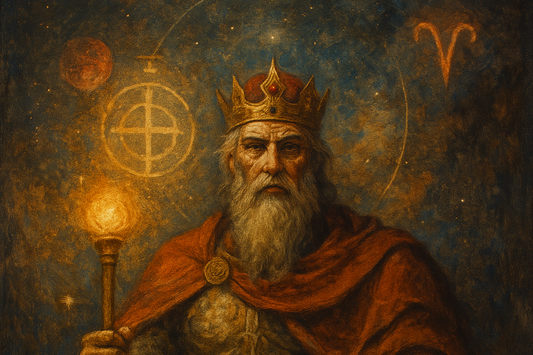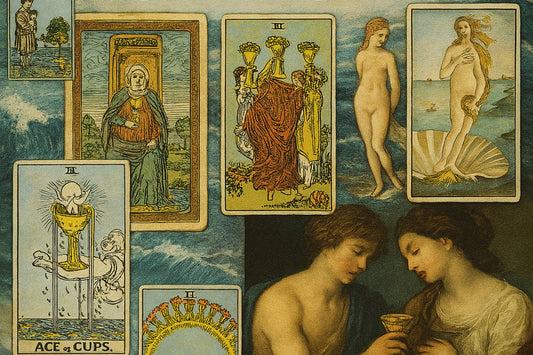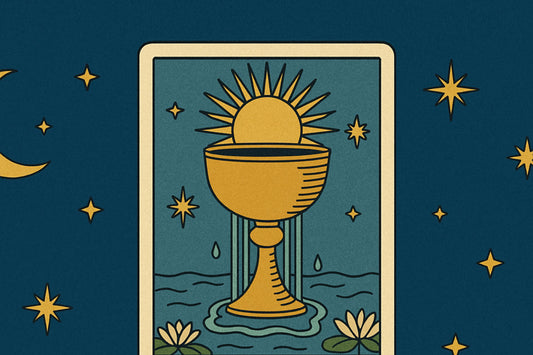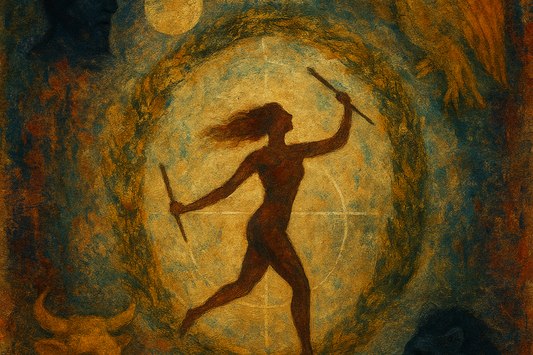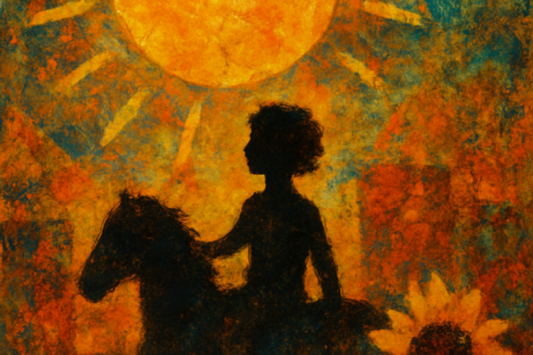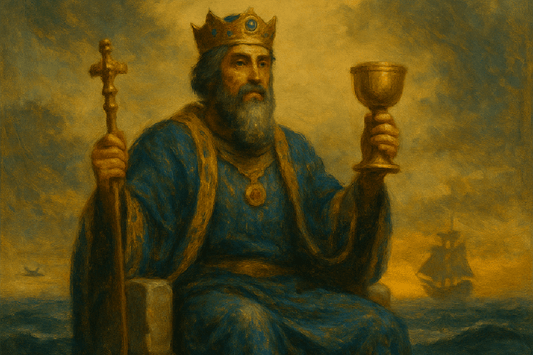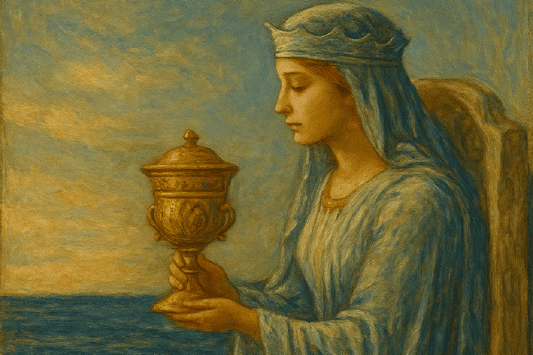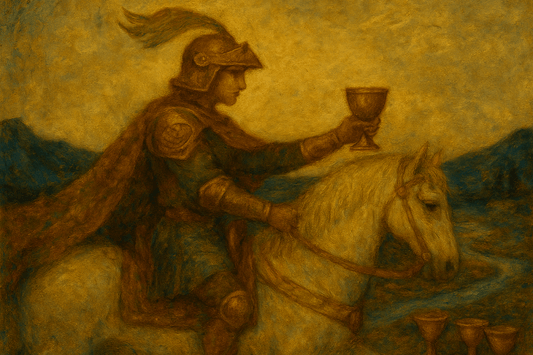The Hierophant in Tarot: Tradition, Transmission and Sacred Order
Tarot AccessoriesTable of Contents
- TL;DR: The Hierophant Quick Reference
- The Archetype of The Hierophant in the Tarot
- Symbolism and Imagery of The Hierophant
- Meaning of The Hierophant in a Tarot Reading
- Reversed Meaning of The Hierophant in a Tarot Reading
- The Evolution of The Hierophant Throughout History
- Numerology and the Number Five in Tarot
- Astrological Resonance of The Hierophant
- FAQs About The Hierophant in Tarot

TL;DR: The Hierophant Quick Reference
Upright: Tradition, spiritual structure, inner authority, sacred teaching, divine law, belief systems, mentorship, community, legacy, initiation, institutional power, guidance
Reversed: Rebellion, dogma, spiritual bypassing, misuse of power, questioning tradition, rigid thinking, mistrust in institutions, anti-authority, blocked faith, rejection of inherited belief
The Archetype of The Hierophant in the Tarot
The Hierophant is the bridge between human and divine law. He stands as the holder of spiritual lineage - the transmitter of sacred knowledge, not as a prophet, but as a vessel of tradition. He teaches not from ego, but from continuity. From structure. From memory.
This is the card of the ritual keeper - the one who preserves teachings not by invention, but by repetition. He governs initiation, blessing, sacred order. Where The High Priestess holds the mystery in silence, The Hierophant speaks it aloud - within a framework that protects its power.
He is often misunderstood as merely “religion” - but his true essence is the tension between inner truth and external tradition. The Hierophant asks: do you follow what has come before - or are you ready to make it your own?
When this card appears, you are being invited to locate yourself inside a larger lineage - ancestral, spiritual, ideological. The question isn’t “What do you believe?” - it’s “Where does that belief come from?” And “Are you willing to be shaped by it - or outgrow it?”
Related Cards to Explore
The Fool in Tarot: Sacred Trust, Archetypal Innocence and New Beginnings
The Magician in Tarot: Manifestation, Will and the Power to Begin
The High Priestess in Tarot: Inner Knowing, Mystery and Sacred Stillness
The Empress in Tarot: Fertility, Creation and Archetypal Abundance
The Emperor in Tarot: Structure, Sovereignty and the Archetype of Order
Symbolism and Imagery of The Hierophant
In the Rider-Waite-Smith deck, The Hierophant sits on a stone throne between two grey columns, echoing those of The High Priestess - but now square, rigid, architectural. Above him - a triple-tiered crown, also known as The Triregnum or the Papal Tiara marks the three realms: body, mind, and spirit. In his left hand he holds a papal cross, symbol of layered spiritual authority. His right hand is raised in benediction - two fingers up, two down - blessing both heaven and earth.
At his feet kneel two acolytes, each wearing a rose and lily on their robes - signs of desire and purity, devotion and thought. Between them lie crossed keys - symbols of esoteric knowledge, initiation, and access.
Unlike The Magician, who channels divine energy directly, The Hierophant mediates it. He transmits sacred wisdom through form: ritual, scripture, code, covenant. He is not mystery - he is doctrine.
The greyness of the card is deliberate. This is not a place of mysticism - but of systems, rules, boundaries, and belief.
Meaning of The Hierophant in a Tarot Reading
When The Hierophant appears, you are being asked to sit with structure - spiritual, social, or psychological. This is a moment of initiation - a call to take something seriously enough to let it shape you. Whether a lineage, a belief system, a mentor, or a commitment - this card says: let this matter.
It can indicate:
- Being part of a larger community
- Seeking out sacred guidance
- Embracing traditional wisdom
- Entering a formal passage (marriage, study, devotion, healing)
It also speaks to internal structure - your beliefs, your principles, your personal code. Where did they come from? Are they inherited, or consciously chosen?
The Hierophant invites reverence - not blind faith. He reminds us that not all structure is oppressive. Some of it is sacred.
Reversed Meaning of The Hierophant in a Tarot Reading
Reversed, The Hierophant challenges your relationship to tradition, belief, and institutional power. You may be:
- Rebelling against inherited systems
- Feeling trapped in rigid frameworks
- Questioning long-held truths
- Resisting outside authority
This card can appear when religion becomes dogma, when wisdom is used to control, or when spiritual truth is reduced to empty performance.
Reversal may also point inward - to your own spiritual bypassing, your resistance to discipline, or your fear of surrendering to a path that might ask more of you than you're ready to give.
But it can also be healthy rebellion. Sometimes, to find your truth, you must first confront the one you were given.
The Evolution of The Hierophant Throughout History

Early Tarot – The Pope, Not the Hierophant
In early decks like the Visconti-Sforza, The Hierophant appears as The Pope (Il Papa) - the ultimate religious authority in Renaissance Europe. Seated on a throne, flanked by acolytes, wearing full papal vestments, he blesses and teaches. This was not archetype - this was power made visible. A figure both revered and politically loaded.
The Pope represented spiritual order, divine hierarchy, and the absolute moral centre. His inclusion in tarot positioned him as the arbiter of sacred knowledge.

Christian Overlay – Papal Authority and Sacred Mediation
During this era, the Pope figure reflected deep Christian overlays in tarot’s development - mirroring the actual social and ecclesial power structures of Europe. The card represented not just religion, but institutionalised spirituality - a mix of divinity and control.
He wasn’t just spiritual. He was the Church.

Marseille Tradition – Il Pape Retained
In the Tarot de Marseille, the figure remains Il Pape - still blessing, still enthroned, still flanked by followers. But the details shift slightly: the symbolism becomes more stylised, more abstracted. The focus is less personal, more structural.
The Marseille Pope is less charismatic - more of a position than a person. He becomes the icon of spiritual system: a gatekeeper of hidden knowledge and a transmitter of moral law.
Golden Dawn and the Esoteric Hierophant

With the rise of esoteric tarot in the 18th–19th centuries, the card was renamed The Hierophant - a title taken from ancient Greece, where a Hierophant was a high priest who initiated candidates into the Eleusinian Mysteries.
This shift was intentional. It reframed the card away from Christianity and toward universal spiritual structure. The Hierophant became a symbol of sacred transmission - one who carries the codes of initiation from one generation to the next.
The Golden Dawn assigned the new Hierophant to Taurus, ruled by Venus - grounding spiritual authority in earth, value, and stability. They placed him on Path 16 of the Tree of Life, connecting Chokmah (Wisdom) and Chesed (Mercy).

RWS Deck – Institutional Power Reimagined
In the Rider-Waite-Smith deck (1909), the figure is no longer called The Pope - but The Hierophant. Yet the papal symbolism remains.
Pamela Colman Smith illustrates him in full ecclesiastical regalia. But it’s colder. More structured. More austere. He becomes not a man of God, but an archetype of divine order - one who teaches not from ecstasy, but from discipline.
The two followers below him represent initiation - seekers ready to enter into sacred knowledge. The keys are crossed at his feet. The door will open - but only if you are willing to receive the teachings.
Modern Decks - From Institution to Inner Authority
In contemporary decks, The Hierophant is often reimagined - and often resisted.
Some depictions soften him into a spiritual teacher, mentor, or healer. Others subvert the image entirely, painting him as a genderless wisdom keeper, a burning book, or a collapsing temple.
But the core remains: this card asks you to honour structure - or to question it. To locate yourself in a lineage - or to break it. It reminds us that tradition is not the enemy. It is the scaffold from which we build meaning.
Numerology and the Number Five in Tarot
Five is the first true disruption. If Four is foundation, Five is the tremor - the tension that cracks open stability. Five introduces conflict, growth, and spiritual testing.
In The Hierophant, Five becomes the teaching moment. The structure of tradition must be engaged with - not blindly obeyed. There is pressure in this number - but also the possibility of integration.
Five marks the space where belief is tested - where the seeker becomes the student, and the student becomes the vessel for something greater than the self.
Astrological Resonance of The Hierophant
The Hierophant is associated with Taurus, ruled by Venus. Taurus governs values, embodiment, patience, and long-term stability. Venus brings connection, attraction, and harmony - but Taurus grounds those qualities into practice.
This pairing is important: The Hierophant is not about fleeting belief. He is about lived value - tradition that is rooted, practiced, and integrated.
Taurus also resists change - a theme that lives inside the card. This archetype doesn’t shift easily. But when it does, the shift is total.
The Venusian layer reminds us that spiritual teaching is not just law - it is beauty. It must be felt to be understood.
FAQs About The Hierophant in Tarot
What does The Hierophant mean in a love reading?
In love, The Hierophant can represent traditional commitment - marriage, spiritual union, or a connection rooted in shared values. It may also indicate a relationship guided by a mentor, community, or moral compass. Alternatively, it can reflect a need for structure, clarity, or agreed-upon terms.
Is The Hierophant a yes or no card?
The Hierophant is generally a yes, especially in questions related to tradition, structure, or commitment. However, it suggests that the answer lies within a framework - and that the question may need to be filtered through a lens of values and integrity.
What does The Hierophant mean when reversed?
Reversed, The Hierophant challenges your relationship to authority and tradition. It may indicate rebellion, questioning inherited belief, or feeling restricted by dogma. It can also signal misuse of spiritual power - or the need to find your truth outside of institutions.
What archetype does The Hierophant represent?
The Hierophant is the archetype of the Sacred Teacher, the Lineage Holder, and the Spiritual Bridge. He reminds us that wisdom must be carried - and that every teaching requires both structure and soul to be received.
What’s the difference between The Hierophant and The High Priestess?
The High Priestess is inner knowing - The Hierophant is outer teaching. She guards the mystery. He shares it. Together, they form the axis of sacred knowledge - one silent, one spoken.


